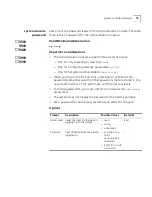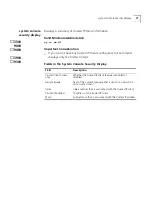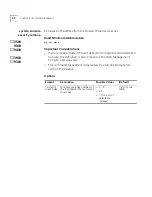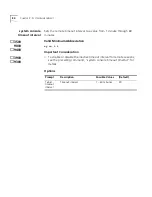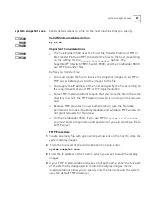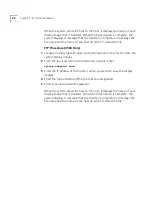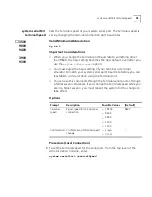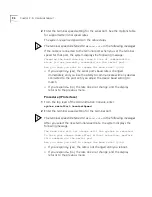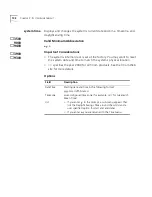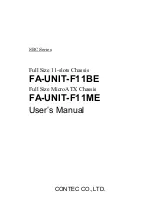
system snapshot save
87
✓
3500
9000
✓
9400
✓
3900
✓
9300
system snapshot save
Sends detail screens to a file on the host machine that you specify.
Valid Minimum Abbreviation
sy sn sa
Important Considerations
■
The CoreBuilder 3500 uses the Trivial File Transfer Protocol (TFTP) or
File Transfer Protocol (FTP) to transfer the files to the host, depending
on the setting for the
system fileTransfer
option. The
SuperStack
®
II Switch 3900, Switch 9300, and the CoreBuilder 9400
use TFTP to transfer files.
Before you transfer files:
■
You must create the file to receive the snapshot images on an FTP or
TFTP server
before
you send the images to the file.
■
You supply the IP address of the host and specify the file according to
the requirements of your TFTP or FTP implementation.
■
Some TFTP implementations require that you store the file in the same
directory in which the TFTP daemon (server) is running on the remote
host.
■
Because TFTP provides no user authentication, give the file
loose
permissions to make it publicly readable and writable. TFTP servers do
not grant requests for file access.
■
On the CoreBuilder 3500, if you use FTP for
system fileTransfer
,
you must enter a login name and password if you are sending a file to
an FTP server.
TFTP Procedure
1
Create an empty file with open write permissions on the host to store the
system display images.
2
From the top level of the Administration Console, enter:
system snapshot save
3
Enter the IP address of the host on which you want to save the display
images.
4
If your TFTP implementation requires a full path name, enter the full path
of the file that is designated to contain the display images. (Some
implementations allow you to specify only the file name and the system
uses the default TFTP directory.)
Summary of Contents for CoreBuilder 9000
Page 18: ......
Page 26: ...26 ABOUT THIS GUIDE ...
Page 27: ...I GETTING STARTED Chapter 1 Administration Overview Chapter 2 Command Summary ...
Page 28: ......
Page 64: ...64 CHAPTER 2 COMMAND SUMMARY ...
Page 65: ...II SYSTEM LEVEL FUNCTIONS Chapter 3 System Environment Chapter 4 Module Environment ...
Page 66: ......
Page 148: ......
Page 202: ......
Page 248: ...248 CHAPTER 8 FIBER DISTRIBUTED DATA INTERFACE FDDI ...
Page 250: ......
Page 320: ...320 CHAPTER 11 TRUNKS ...
Page 368: ...368 CHAPTER 14 VIRTUAL LANS VLANS ...
Page 394: ......
Page 502: ...502 CHAPTER 17 VIRTUAL ROUTER REDUNDANCY VRRP ...
Page 604: ...604 CHAPTER 19 OPEN SHORTEST PATH FIRST OSPF ...
Page 660: ...660 CHAPTER 20 IPX ...
Page 687: ...VII TRAFFIC POLICY Chapter 22 Quality of Service QoS and RSVP ...
Page 688: ......
Page 744: ...744 CHAPTER 22 QUALITY OF SERVICE QOS AND RSVP ...
Page 745: ...VIII MONITORING Chapter 23 Event Log Chapter 24 Roving Analysis ...
Page 746: ......
Page 754: ...754 CHAPTER 23 EVENT LOG ...
Page 764: ...764 CHAPTER 24 ROVING ANALYSIS ...
Page 765: ...IX REFERENCE Appendix A Technical Support ...
Page 766: ......
Page 772: ...772 APPENDIX A TECHNICAL SUPPORT ...
Page 784: ......



